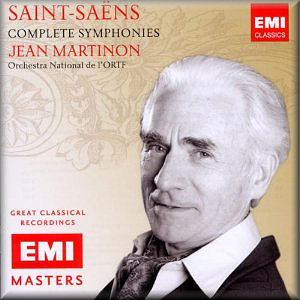 |
 |
|


alternatively
CD: MDT
AmazonUK
AmazonUS
|
Camille SAINT-SAňNS
(1835-1921)
The Complete Symphonies
Symphony in A major (1850) [25:04]
Symphony No.1 in E flat Op.2 (1852) [30:41]
Symphony No.2 in A minor Op.55 (1878) [22:43]
Symphony in F 'Urbs Roma' (1856) [40:37]
Symphony No.3 in C minor Op.78 'Organ' (1886) [36:15]
 Orchestre National de l'ORTF/Jean Martinon
Orchestre National de l'ORTF/Jean Martinon
Bernard Gavoty (organ)
rec. 18-23 November 1974, Salle Wagram, Paris (in A); 18-23 November
1974, Salle Wagram, Paris (Urbs); 11-12 July and 29-30 November
1972, Salle Wagram, Paris (1, 2); 9-10 January 1975, …glise Saint-Louis
des Invalides, Paris (3). ADD
 EMI CLASSICS 6318042 [79:05 + 77:13]
EMI CLASSICS 6318042 [79:05 + 77:13] 
|
|
|
To call Saint-SaŽns' output uneven is to put it mildly, and
this cycle of his symphonies demonstrates what a problem that
can be. The Third is far and away the best work here, and the
other four symphonies don't even come close. But that doesn't
mean they're not worth listening to. The difficulty is in forgetting
about the Third while you're listening to the others and considering
each on its own terms. In fact, EMI would have done Saint-SaŽns'
first four symphonies a real favour by omitting the Organ Symphony
altogether, although I don't think their accountants would warm
to the idea.
Another big problem for Saint-SaŽns was his prodigious juvenilia,
and among the child prodigy composers throughout musical history,
he was surely amongst the busiest in his early years. The three
unnumbered symphonies here are the largest-scale of his early
works. The Symphony in A dates from around his 15th
year, while the Symphony in F 'Urbs Roma' was written as an
entry for a competition, one that he won without too much trouble.
But he was wise not to publish or number either of those works,
as they pale in comparison to the other three. The unpublished
symphonies show proficiency in terms of orchestration and in
generally fulfilling the generic requirements of the form. But
they lack originality, and there isn't much direction to the
music. On the other hand, they provide excellent preparatory
listening for those seeking to contextualise the mature symphonies.
The primary influences on all of Saint-SaŽns' symphonies seem
to be Bach, Mozart and Beethoven, the latter mediated by Schumann.
Listening to the youthful symphonies, it is fascinating to hear
how the composer takes Mozart as the starting point for a symphonic
style that takes its formal responsibilities lightly. Inner
movements are always sprightly and never far from the rhythm
of a dance. And the outer movements tend towards the grandeur
of Beethoven, but there is always a sense of reticence (typically
French) towards the pomposity of Beethoven's strident, heroic
style.
Of the first two numbered symphonies, the Second is by far the
superior. It is definitely the closest in style and accomplishment
to the Organ Symphony, and like its more famous successor, it
successfully conjoins the Baroque counterpoint of Bach, the
Classical opulence of Beethoven, and the French Romantic warmth
that is distinctively Saint-SaŽns. The fugal, or at least contrapuntal,
first movement has shades of the Organ Symphony's finale, while
the stately second movement takes us back to Mozart, not as
pastiche, but rather as fully digested influence.
To my knowledge, this is the only available complete set of
Saint-SaŽns' symphonies, but this is at least its second, and
possibly its third, appearance on CD (review).
That said, each of the symphonies is available elsewhere, and
I think the BIS and ASV between them could offer the full set.
However, it is only really the Third Symphony that is subject
to rigorous competition, and by modern standards the performance
and recording quality are reasonable at best. Jean Martinon
and his players never exaggerate anything in the music, which
means we are thankfully spared some of the worst interpretive
excesses that can befall the finale. On the other hand, they
are often relaxed to a fault, especially in the first movement,
or rather the first half of the first movement if we are to
follow the composer's bipartite scheme. Where other conductors
would inject some momentum where the exposition emerges from
the slow introduction, Martinon continues at a relaxed pace,
and continues in that vein for pretty much the whole symphony.
The roundness of the string sound is bonus, as is the definition
of in the bass. But the string ensemble is loose by modern standards,
and the woodwind aren't much better. The best playing from the
orchestra comes from the brass and percussion. The solo trumpet
is distinctive and has a wonderfully slow, narrow vibrato, it's
almost a spaghetti western sound. The timpanist has his work
cut out in this symphony and he (I'm assuming) really makes
the most of it. That focused penetrating tone of the lower timps
provides the perfect compliment to the roundness of the string
sound.
Generally, the sound quality is good for the early 1970s, but
never exceptional. For obvious reasons, the orchestra moves
into church – Les Invalides no less – for the Organ Symphony,
but the engineers manage to retain the apparent resonance at
concert hall levels. The piano is artificially amplified in
the finale to the point of excess, while the balance between
the organ and the orchestra is just about right.
But you're not going to buy this set for the Organ Symphony.
It is the first and second numbered symphonies that make this
set worthwhile. I've no doubt that both works appear somewhere
on a to-do list at Naxos, but until they get round to it this
is probably the best of the few options available.
Gavin Dixon
|
|

